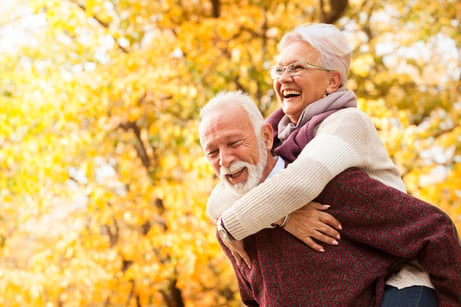 When we think of aging, some think about wrinkles, aches, and pains and the negative associations of the aging process. Yet there is so much more to aging! No, we cannot stop the aging process, but we can choose to live a healthy lifestyle. This is the time to do things you have never done and find enjoyment. Here are just a few things to consider when aging gracefully and living your best life!
When we think of aging, some think about wrinkles, aches, and pains and the negative associations of the aging process. Yet there is so much more to aging! No, we cannot stop the aging process, but we can choose to live a healthy lifestyle. This is the time to do things you have never done and find enjoyment. Here are just a few things to consider when aging gracefully and living your best life!
Be nice to your skin
To keep your skin looking and feeling at its best:
- Stay hydrate. On average we should drink 7-8 cups of water a day to keep our skin looking good and our body functioning appropriately. When we become dehydrated our skin can become dry and folded.
- Wear sunscreen and even a hat to keep the sun off your face
- Wear sunglasses when outdoors to protect your eyes from sun damage
- Use gentle skin care products
- Make sure and have a yearly skin cancer screening
Exercise
Regular exercise helps control your cholesterol, blood pressure, body weight, and reduces the risk of hardening of the arteries, stroke, and heart attack. A good fitness program conditions muscles, tendons, ligaments, and bones to stimulate bone growth and helps prevent osteoporosis while keeping your body limber and lowering your chances of injury. Exercise is also good for managing low back pain, arthritis, and diabetes. Incorporating regular exercise into your life can help you feel better, sleep better and give you the endurance to enjoy your best life.
- It is recommended to participate in cardiovascular exercise 3-5x/week for 30-60 minutes. Walking, dancing, and cycling are examples of cardiovascular exercise.
- It is also recommended to do strengthening exercises 2-3/week. These exercises can be done with weights or bands.
Proper Diet
- Eat food high in fiber to help with healthy digestion and to avoid constipation. High fiber foods will also make your belly full! Men 51+ need 30 grams of fiber and women 51+ need 21 grams of fiber daily. When increasing your fiber intake start slow and work up to the proper daily intake.
- Fill your plate with 50% fruits and veggies, 25% grains and 25% lean protein. Try to use fresh fruits and veggies that aren’t saturated in sugars and sauces. When choosing grains look for items that are whole grain such as bread, cereals, rice or pasta. And when choosing proteins go for the those that are lean in fat such as peanut butter, nuts/seed, bean, fish, or chicken.
- Limit foods high in cholesterol, sugar and saturated or trans fats.
- Refer to myplate.org for more dietary guidelines for older adults
Mental Health and Mindfulness
Being happy and healthy goes a long way when it comes to mental health. Many factors can affect our mental health and some we don’t even realize. Being mindful of our stresses can improve our focus and our memory.
- To keep your mental health in check surround yourself with good people. People who motivate you to be better and give off positive energy. Spend time with family, friends and loved ones.
- Accept your age. Aging is unavoidable so learn to embrace it and live that best life
- Get sleep. Aim for seven to eight hours of sleep a night. Shut off the electronics and let your brain relax and let your body rest. Getting enough sleep can help reduce stress, depression and even lower your risk of obesity.
- Accept and live in the moment. Focus on the present and don’t stress over things you can’t fix. Engage in activities such as yoga or tai chi.
Though aging is inevitable we can influence how our journey goes. It is never too late to start making healthy choices for a healthier happy future. Now is the time to age with grace and start living your best life!!


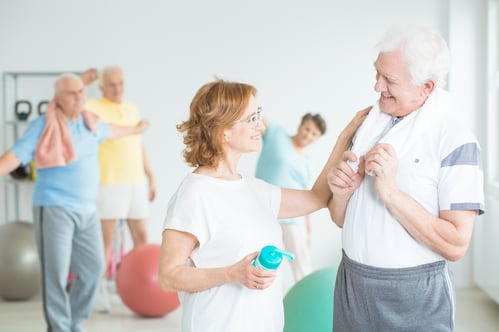 As we age, we are constantly looking for ways to continue living our lives to the absolute fullest. One key element to reducing the effects of aging and to warding off possible health threats is to sustain a healthy and active lifestyle!
As we age, we are constantly looking for ways to continue living our lives to the absolute fullest. One key element to reducing the effects of aging and to warding off possible health threats is to sustain a healthy and active lifestyle!.jpg?width=467&name=GettyImages-1225625994%20(1).jpg) In
In 
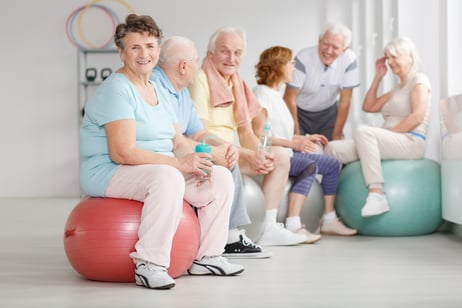 In the Active Aging community, group fitness is a large part of a resident’s daily life. Exercising solo and following a written workout plan doesn’t cut it for some residents. They need an extra motivational factor, such as being with a group and having someone instruct them step by step. Having friends around at all times is important to residents. It gives them a sense of security and accomplishment when they look in the mirror and see themselves exercising with close friends in the community.
In the Active Aging community, group fitness is a large part of a resident’s daily life. Exercising solo and following a written workout plan doesn’t cut it for some residents. They need an extra motivational factor, such as being with a group and having someone instruct them step by step. Having friends around at all times is important to residents. It gives them a sense of security and accomplishment when they look in the mirror and see themselves exercising with close friends in the community.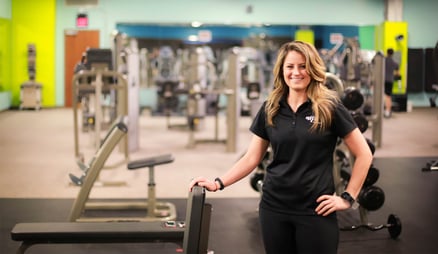 We’re a staffing organization – we provide well-credentialed and passionate fitness professionals to manage senior living fitness centers and corporate fitness programs for our clients. To say we know a thing or two about interviewing could be, perhaps, an understatement. Over the last 30+ years, we’ve hired hundreds of staff to fill a variety of fitness-focused positions for a diverse clientele. We have definitely made some mistakes and we’ve lived to tell about it.
We’re a staffing organization – we provide well-credentialed and passionate fitness professionals to manage senior living fitness centers and corporate fitness programs for our clients. To say we know a thing or two about interviewing could be, perhaps, an understatement. Over the last 30+ years, we’ve hired hundreds of staff to fill a variety of fitness-focused positions for a diverse clientele. We have definitely made some mistakes and we’ve lived to tell about it.
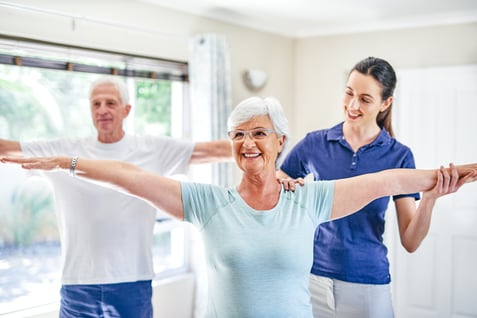 We already know that exercise is a key contributor to a healthy lifestyle overall, but for those with Parkinson’s Disease (PD) this is no exception! In fact, exercise is extremely critical for people with PD, and
We already know that exercise is a key contributor to a healthy lifestyle overall, but for those with Parkinson’s Disease (PD) this is no exception! In fact, exercise is extremely critical for people with PD, and .jpg?width=404&name=GettyImages-1135376317%20(1).jpg) While practicing social distancing remains a priority for everyone, finding ways to stay physically active should also remain a priority. This is particularly true for older adults who may find themselves feeling increasingly isolated and vulnerable to remain safe. Exercise has long proven to provide numerous health benefits both for your physical well-being as well as your emotional well-being including:
While practicing social distancing remains a priority for everyone, finding ways to stay physically active should also remain a priority. This is particularly true for older adults who may find themselves feeling increasingly isolated and vulnerable to remain safe. Exercise has long proven to provide numerous health benefits both for your physical well-being as well as your emotional well-being including:
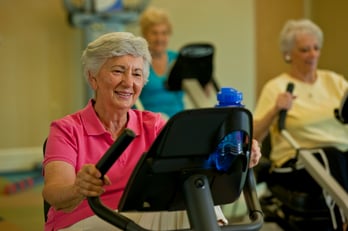 Community wellness programming is one of the most important ways to keep your residents engaged. As wellness professionals, it’s our job to make sure that the programs being put into play are impactful and enjoyable, and continue to set precedents and work on the varying dimensions of wellness.
Community wellness programming is one of the most important ways to keep your residents engaged. As wellness professionals, it’s our job to make sure that the programs being put into play are impactful and enjoyable, and continue to set precedents and work on the varying dimensions of wellness.
.jpg?width=383&name=GettyImages-1008096704%20(1).jpg) All personnel working in a senior living community have a stake in supporting resident well-being from your concierge to your bus drivers to your service staff in the dining room. The daily interactions your team have with residents and the work culture at a community all directly impacts the quality of life of residents. As communities pursue opportunities to both evaluate resident care needs and broader program and service needs under the banner of enrichment, forming a wellness committee of your key stakeholders can be an integral step. Finding the right balance of personnel to represent different arms of the community as well as getting their buy-in with already full workloads can be a tricky step.
All personnel working in a senior living community have a stake in supporting resident well-being from your concierge to your bus drivers to your service staff in the dining room. The daily interactions your team have with residents and the work culture at a community all directly impacts the quality of life of residents. As communities pursue opportunities to both evaluate resident care needs and broader program and service needs under the banner of enrichment, forming a wellness committee of your key stakeholders can be an integral step. Finding the right balance of personnel to represent different arms of the community as well as getting their buy-in with already full workloads can be a tricky step.
.jpg?width=447&name=GettyImages-1173137476%20(1).jpg) Oh, my aching feet! More importantly, why do my feet hurt? Let me explain further. At times in the past, the top of my foot has felt like it was being crushed by the laces of my sneakers. I logically thought that all I needed to do was loosen the laces of my sneakers and it would solve the problem. It did not help. Really, all it did was create more problems because then my sneakers felt like they were going to fall off, and then the loose-fitting sneakers began to rub on and irritate my heels. On top of that, when I did loosen the laces, the shoes would then come untied too easily.
Oh, my aching feet! More importantly, why do my feet hurt? Let me explain further. At times in the past, the top of my foot has felt like it was being crushed by the laces of my sneakers. I logically thought that all I needed to do was loosen the laces of my sneakers and it would solve the problem. It did not help. Really, all it did was create more problems because then my sneakers felt like they were going to fall off, and then the loose-fitting sneakers began to rub on and irritate my heels. On top of that, when I did loosen the laces, the shoes would then come untied too easily.